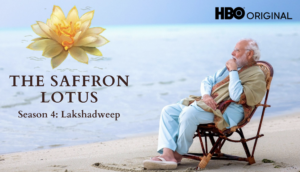
As Muslim women lead India’s battle for democracy, Bollywood presents them as suicide bombers the Hindu state must save

The “monstrous Muslim” of the Indian cinema of our times is informed by the fevered imagination of Hindutva: in this scheme of things, the Muslim woman does not even exist.

As Muslim women occupied the country’s streets at the close of spring this year, leading the largest, most sustained democratic protests in independent India, Bollywood was busy representing them as misguided suicide bombers. In Special Ops (2020), the web series by Bollywood director-producer Neeraj Pandey, there are two such Muslim women characters with speaking roles among a dashboard of bloodthirsty Muslim men, who are invariably accompanied by ominous music. The younger suicide bomber, played by Revathi Pillai, is a schizophrenic triggered by violence she has experienced earlier in her life. A young adult, she also watches cartoons on television and loves ice-cream and junk treats. Her elder sister—the other suicide bomber played by the well known actress Divya Dutta—indulges her. Both these roles are pretty small in the context of an eight-episode series, each episode an hour long.
But even this is an unusual sighting. Muslim women with speaking roles are rare in the Muslim-baiting Hindi cinema of our times. Right from A Wednesday (2008), Pandey’s hyper-nationalist thriller brand of cinema has a tradition of slyly baiting Muslims while appearing to be no-nonsense taut narratives. This seeming fairness is usually achieved by the presence of a couple of “good Muslims” serving in the forces in the plotline, a routine device several decades old in Bollywood films to deflect criticism of demonising Muslims. (Technically, Special Ops may be a web series but effectively it is a longer version of the Pandey brand of cinema—just that this one does not feature superstar Akshay Kumar.)
Anubhav Sinha, another Hindi film maker, in his film Mulk (2018) has nicely explored what this Good Muslim, or sarkari musalman, is: Muslims who with some measure of privilege and some of their own initiative manage to rise up the ranks of the Indian establishment and develop a loathing for Muslims who don’t. Yet even in Mulk, which is about a Muslim family battling Islamophobia, the Muslim women are domestic, and the woman who does the progressive talking is the family’s Hindu daughter-in-law.
The Pandey genre of hyper-nationalist thriller, where the Indian secret services foil the global Muslim terror plot, has become a certified box-office success in the Hindi film industry. The other Hindi film genre that has become fail-proof, is the lavish historical like Padmaavat, Kesari, or Panipat where the moral courage of Indian warriors (this can include Sikhs) defeats marauding Muslim armies. In the Pandey thrillers, the Muslim woman is either oppressed or deluded like in Special Ops. She needs to be saved, and sometimes it is the Indian state that steps in to save her by recruiting her in their services. Special Ops has one character like this; we barely know anything about her character except that she can beat up bad men and bring them to line. The other women are the deluded suicide bombers. In the historicals, the Muslim woman is mostly unseen, creating an impression of Islam as rampaging armies of men starved without women.
The irony of it struck especially hard in the post-Shaheen Bagh moment. The largest, most sustained protest in independent India is a movement led by Muslim women, many of them described as homemakers. Bollywood shapes, for what it is worth, the imagination of a vast number of people who watch its cinema. The Muslim man has been consistently bestialised in a series of blockbuster hits, by now we all know this. And the Muslim woman is a non-entity. In this sense, the persona of Nazma Aapi created by the comedian Saloni Gaur does, in a way, fill a void. She presents us with a regular Muslim woman in popular culture, which our wealthiest cultural industry, Bollywood, does not.
The genre of hyper-nationalist thriller, where Indian secret services foil global Muslim terror plots, has become a certified box-office success in India. The other fail-proof genre is the lavish historical where upright Indian warriors defeat marauding Muslim armies. I should make a distinction here: the Muslim woman has appeared in a large number of Hindi films, chiefly the genre known as the “Muslim social” where stories are set in a wholly Islamic setting. This was very popular until the 1960s, but we see the Muslim film occasionally in subsequent decades too: films like Pakeezah (1972), Umrao Jaan (1981), Fiza (2000), Gully Boy (2019) in the mainstream register, and Mammo (1994), Naseem (1995), Sardari Begum (1996) in the alternative register. Incidentally, in the iconic Hindi film Amar Akbar Anthony (1975) about three brothers lost in childhood and adopted in three different faiths, it is the Muslim woman who is a doctor. The Hindu woman is a con girl, and the Christian woman is a rich girl who does nothing. In Modi’s India, this film seems impossible even though Bollywood is remaking much slighter films to cash in on the nostalgia.
Consider the last Hindi film hit before the theatres closed for the lockdown in India. In Baaghi 3, hero Tiger Shroff promised to erase Syria from the map of the world. The war-ravaged Muslim country is shown to be run by a militia in black robes with kohl-rimmed eyes, possessing an abundance of helicopters and armed combat vehicles. Their revenue model is kidnapping families from South Asia and blackmailing the men into becoming suicide bombers for them. The militia is supposed to represent the Islamic State (IS). (In truth, the IS lost control of all the territory it had gained in Syria by March 2019.) There are no women to be seen in this Muslim nation except a constellation of barely-clothed women at a night club. The only woman who speaks on screen is the (Hindu) hero’s girlfriend, played by Shraddha Kapoor, who marks her presence in the woman-free landscape by keeping her blow-dried mane open throughout, even the time that three armoured vehicles chase her.
In this year’s biggest box office success so far, Tanhaji, Saif Ali Khan plays the almost-Muslim—that is to say, his name is Uday Bhan but he is loyal to the Mughals. He grills a crocodile for dinner, preys on women and generally behaves very badly and has a lot of fun. There is, however, no woman character who is close to him. Neither is there any woman in the Mughal dynasty, shown in the form of a dour, pale Aurangzeb.
In War, the biggest blockbuster in Bollywood in 2019, the Tiger Shroff character’s father was the Bad Muslim who sold out the country’s secrets. The Good Muslim was the son, determined to make amends. His mother, a Muslim woman played by Soni Razdan, had two scenes in the film, one where she brought food for her son and another where she mutely accepts an award. War is perhaps the most egregious of these films, in that it shows the good Muslim to be an eyewash, an illusion maintained by a sleight of hand.
In 2019, there was also Panipat. Here, the Bad Muslim is the Afghan ruler Ahmad Shah Abdali played by Sanjay Dutt. Abdali wears black, devours meat, has scars running through his face and is a ruthless enemy at war. His life is a singularly male sphere, untouched by women. There is no presence or even memory of a mother or mother figure who left an impression on him.
Another huge success of 2019 is Kesari. It tells the story of 21 Sikh soldiers fighting for the British colonial army to protect Sargarhi, a western border outpost. The Afghans are a murderous crowd of thousands rushing in to destroy the British regiment. Our Sikh hero Akshay Kumar is given a backstory with a wife, but the marauding Afghans are men without history, there is nothing remotely human in their depiction, and perhaps this is why they are shown as men without women, families, or children. They are only a huge mob of marauders. With the exception of Panipat, which was a box office failure, most of these Muslim-bashing movies named here were blockbusters.
Think also of the first blockbuster with a Hindu-Muslim dynamic after Prime Minister Modi’s BJP government was voted to power in 2014. Bajrangi Bhaijaan had none of the virulence of later films such as Padmaavat, Tanhaji, or Pandey’s brand of seemingly no-nonsense cinema. The film is the story of a mute, six-year-old Pakistani girl found lost in India by hero Salman Khan. She is a Muslim, and she speaks four words in the last five minutes of the 163-minute film when she finds her voice and calls Khan “maama” and follows up with the war-cry that’s magic to the BJP: Jai Shree Ram! Wonder if this silent, beautiful child now personifies the Muslim woman in the popular imagination—a voiceless, helpless victim of circumstances who needs saving. Either by a Hindu man or the Indian, read Hindu, state. In a couple of projects by Pandey, Indian Muslim women have been cast as spies in the Indian establishment.
There are exceptions to this. Sayani Gupta played the conscience of the fake-encounter film Jolly LLB 2 (2017), a pregnant young widow who believes the Indian judiciary will give her late husband the justice he was denied in life. There are the frankly incredible personas of Aishwarya Rai as Sabah the poet and Anushka Sharma as Alizeh the cancer patient (does she have a professional identity?) in Ae Dil Hai Mushkil (2016). These women are deeply satisfying as ideas, both are headstrong women, unashamed of articulating desire. But on screen, they seem improbable, so wealthy that their identity seems untouched by anything except wealth. Still, it is so unusual to have a creative woman on the Hindi film screen in the first place—and Sabah is Muslim, an identity the public discourse associates with burqa, talaq and naivete. (All the artists and writers are men, think and see.) Another, more obvious candidate is Konkona Sen Sharma’s resourceful saleswoman in Lipstick Under My Burkha (2016) who knows her abusive, good-for-nothing husband is cheating on her and avenges herself through a remarkable sales pitch. She is quiet, ambitious, and knows that only she can right the wrongs done to her in her bad marriage.
That brings us back to Padmaavat, the most complex of these films which arguably began the making of Muslim men into beasts and found superb box office success for it. Here, Alauddin Khilji’s wife, the empress Mehr-un-Nisa, has a considerable role right from the start. She is played by the actress and dancer Aditi Rao Hydari, and has a crucial role to play in the story. We see her first as a young woman in thrall of Khilji who asks for her hand in marriage. Then, as she comes to know her husband, she turns quieter but seemingly not bitter. Although Khilji has lusted for Padmavati in her presence, she helps Padmavati and her husband Ratan Singh escape through the dungeons out of their camp. Khilji sentences her to death for this act. Her life is lived in the emperor’s shadow, yet Mehr-un-Nisa becomes her own quiet person. It is an irony that mirrors the film’s—Padmaavat began the portrayal of the bestial Muslim, yet Bhansali fashioned a memorable and brave woman within it, the only woman of note in the new Islamicate of Bollywood.
Why should it matter, this business of women, whether they exist or not? Because it speaks of how public imagination is constructed. Popular Hindi cinema functions as the projection of New Delhi’s imagination. The films of Bombay have ventriloquised Delhi’s messages—why else would a city in a Marathi speaking land make films in a language spoken by the northern part of the Indian Union? The Monstrous Muslim is the fevered imagination of Hindutva politics, and in this imagination, the Muslim woman does not exist.
Hence, public policy is shaped to bring the Muslim man to heel and “save” Muslim women: the Muslim Women Act 2019 lays out criminal imprisonment upto three years for men who divorce their wives by instantly saying talaq (divorce) thrice, but mentions no provisions for women who may be abandoned without triple talaq, such as Modi’s wife Jashodaben. Triple talaq could have been done away with by declaring this method of divorce null and void. On the other hand, in the matter of a petition requesting an end to the practice of female genital mutilation practised by Dawoodi Bohras, the Modi government has stalled, saying this is a matter of religious belief. In other words, real reform in the lives of Muslim women is unimportant, what matters is criminalising the Muslim man.
If the thousands of Shaheen Baghs that bloomed across India are any indication—if anybody required one—Muslim women don’t need any saving. Like the “poor, enslaved” empress Mehr-un-Nisa who helped Padmavati escape with her husband through a secret dungeon, they have probably saved us and healed us in many ways, small and big, in these haemorrhaging months. In the climax, when Khilji attacks their kingdom, Padmavati kills herself by immolation alongside other women—a practice known as jauhar—an act of “bravery” marking her determination not to be captured by the “bestial” Muslims. On the other hand, Mehr-un-Nisa chooses to save a woman who had captured her husband’s fantasy, for which she is punished by hanging.
Both women make suicidal decisions. One walks to her death and the other shows a generosity that she knows may get her killed. Jauhar is sanctioned by society, while Mehr-un-Nisa’s call is wholly and unexpectedly her own. Whose life choices, then, are more sovereign? For all the blame that is legitimately laid at Bhansali’s door, he may yet have shown us something we find so difficult to realise. What shouldn’t be difficult to see is that the distance between real Muslim lives and how Bollywood represents them has never been greater, and dangerous, than it is now. And in doing so, it is only peddling the Monstrous Muslim of Hindutva’s fevered imagination.





